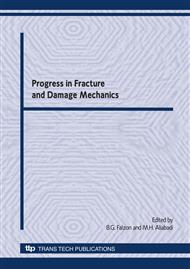p.1
p.25
p.35
p.53
p.67
p.85
p.97
p.109
An Experimental and Numerical Study of the Static and Fatigue Performance of a Composite Adhesive Repair
Abstract:
Experimental static and fatigue tension-tension tests were carried out on 5HS/RTM6 composite intact coupons and coupons incorporating adhesively-bonded (FM300-2) stepped flush joints. The results show that the adhesive joint, which is widely used in repairs, significantly reduces the static strength as well as the fatigue life of the composite. Both, the static and the fatigue failure of the ‘repaired’ coupons occur at the adhesive joint and involve crack initiation and propagation. The latter is modelled using interface finite elements based on the decohezive zone approach. The material degradation in the interface constitutive law is described by a damage variable, which can evolve due to the applied loads as well as the number of fatigue cycles. The fatigue formulation, based on a published model, is adapted to fit the framework of the pseudotransient formulation that is used as a numerical tool to overcome convergence difficulties. The fatigue model requires three material parameters. Numerical tests show that a single set of these parameters can be used to recover, very accurately, the experimental S-N relationship. Sensitivity studies show that the results are not mesh dependent.
Info:
Periodical:
Pages:
25-34
Citation:
Online since:
June 2008
Authors:
Keywords:
Price:
Сopyright:
© 2008 Trans Tech Publications Ltd. All Rights Reserved
Share:
Citation:


